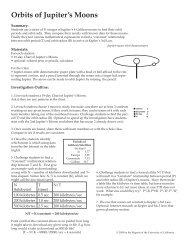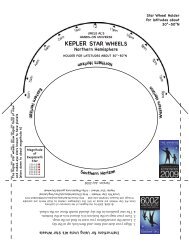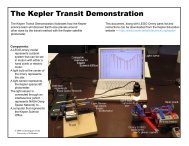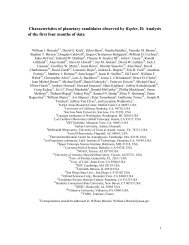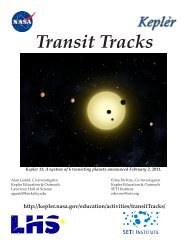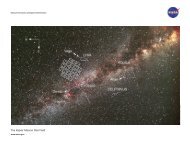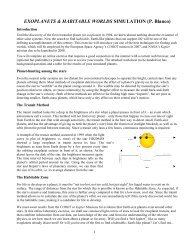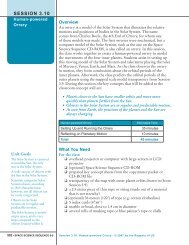POSTER ABSTRACTSP0122. POSTER SESSION IExploiting the accuracy of <strong>Kepler</strong> : Discovery of the hottest andlargest exoplanet. D. Mislis and S. Hodgkin, Institute of Astronomy, University of Cambridge, UK,misldim@ast.cam.ac.uk, sth@ast.cam.ac.ukIntroduction: We present a new approach to determinethe parameters of transiting extrasolar planetarysystems using photometric light curves (LCs). Ananalysis that combines a treatment of various phenomenain high-accuracy LCs allows a derivation of orbitaland physical parameters. Our method considers theprimary transit, the secondary eclipses, and the overallphase shape of a LC between the occultations. Phasevariations are induced by reflected and thermally emittedlight from the planet. Moreover, the ellipsoidalshape of the star due to the gravitational pull from theplanet induce phase variations. As we find, the completedecipherment of LCs yields information aboutthe planetary mass, orbital eccentricity, orientation ofperiastron, and the planet’s albedo. Furthermore, wepresent the analysis of a <strong>Kepler</strong> candidate exoplanetsystem. Using the LC from <strong>Kepler</strong> mission, we havefound ellipsoidal variations due to tidal forces (starplanet),thermal emission from the planet and possiblesignature due to planetary reflected light. The analysishas shown that the system is a hot Jupiter with massMp = 1.20MJ. Because the high temperature of thehost star (SP = A0V , Teff = 8848oK), the exoplanetbecomes one of the hottest exoplanets, with strongthermal emission (Tp = 3341.5o K ). Except ellipsoidalvariations and thermal emission, a weak refleced light component is also present in the LC.1322011 <strong>Kepler</strong> Science Conference - <strong>NASA</strong> Ames Research Center
POSTER ABSTRACTSP0123. POSTER SESSION IDETECTION AND CORRECTION OF STEP DISCONTINUITIES IN KEPLER LIGHT CURVES.R. L. Morris 1,* , J. J. Kolodziejczak 2 , T. Barclay 3 , M. N. Fanelli 3 , J. M. Jenkins 1 , Jeffrey C. Smith 1 , Martin C.Stumpe 1 , J. Twicken 1 , J. Van Cleve 1 . 1 SETI Institute/<strong>NASA</strong> Ames Research Center, MS 244-30, Moffett Field, CA94035, USA, 2 <strong>NASA</strong> Marshall Space Flight Center, 3 Bay Area Environmental Research Institute.* robert.l.morris@nasa.govIntroduction: Approximately one in 30 raw lightcurves in a typical quarter of <strong>Kepler</strong> data contains oneor more noticeable downward step discontinuities. Thevast majority of such discontinuities are the result ofcosmic rays or solar energetic particles striking thephotometer and causing permanent local changes(typically -0.5%) in quantum efficiency, though a partialexponential recovery is often observed [1]. Sincethese features, dubbed Sudden Pixel Sensitivity Dropouts(SPSDs), are not correlated systematics, they cannotbe removed by the systematic error correction algorithmin the Presearch Data Conditioning (PDC)module of the <strong>Kepler</strong> data analysis pipeline. Correctionof SPSD signatures prior to removing systematics notonly rectifies the light curves of affected targets, butcan improve the overall performance of PDC.We present a new algorithm for detecting and correctingSPSD signatures in long-cadence <strong>Kepler</strong> data.The algorithm consists of three components: filter design,detection, and correction. The design of the linearshift-invariant detection filter is based on the methodof Savitzky and Golay [2] with an added multi-scaleanalysis step to improve localization of the peak response.Detection and correction are performed iterativelyon all targets of a given channel until no remainingSPSD signatures are identified.The detection step begins with preconditioning ofeach time series by filling gaps and padding endpoints.Conditioned time series are then convolved with thedetection filter and responses are normalized over alltargets on the current channel. The maximum normalizeddetector response for each target is evaluated inthe context of its light curve to decide first whether it islikely to be the leading edge of a transit or other transientstellar phenomenon, and second whether it indicatesan SPSD event.Correction is a two-stage process. The first stageestimates a persistent step height from analysis of theentire flux time series, excluding a short recovery windowfollowing the SPSD, which typically contains atransient signal. The second stage models the recoverywindow using a series of exponentials of varing timeconstant. The algorithm also detects and preserves sinusoidsin the signal while removing only the step andrecovery transient components.The algorithm has been tested both on unalteredflight data containing signatures of real SPSD events,and on flight data with SPSD-affected targets removedand simulated SPSDs injected. Examples of correctionresults for both cases are shown in figures 1 and 2.Figure 2 illustrates the quality of a typical correctionby comparing corrected and uncorrected light curves toground truth.References: [1] J. M. Jenkins, et al. (2010) ApJ,713, L87. [2] A. Savitzky and M. Golay (1964) AnalyticalChem., 36 (8), 1627-1639.Flux (e/cadence)5.335.325.315.35.295.285.27x 10 8Correction of a Real SPSD Signature(estimated sensitivity drop = 0.52 %)Uncorrected FluxCorrected FluxSPSD cadence3200 3400 3600 3800 4000 4200CadenceFigure 1. Correction of an actual SPSD event in <strong>Kepler</strong>flight data (channel 13.1, quarter 7). In this case,the amplitude of the signal's intrinsic variability iscomparable to that of the downward step.Flux (e/cadence)Flux (e/cadence)Correction of Simulated SPSD Events with GroundTruth Comparisonsx 10 8 (estimated sensitivity drop = 0.5 %)2.9552.952.9452.942.935Uncorrected Flux2.93 Ground TruthCorrected Flux2.925 SPSD cadence2800 3000 3200 3400 3600 3800Cadence3.513.5053.53.4953.493.4853.48x 10 8(estimated sensitivity drop = 0.47 %)100 200 300 400 500 600CadenceFigure 2. Simulation testing indicates a significantreduction in residual errors.2011 <strong>Kepler</strong> Science Conference - <strong>NASA</strong> Ames Research Center 133



